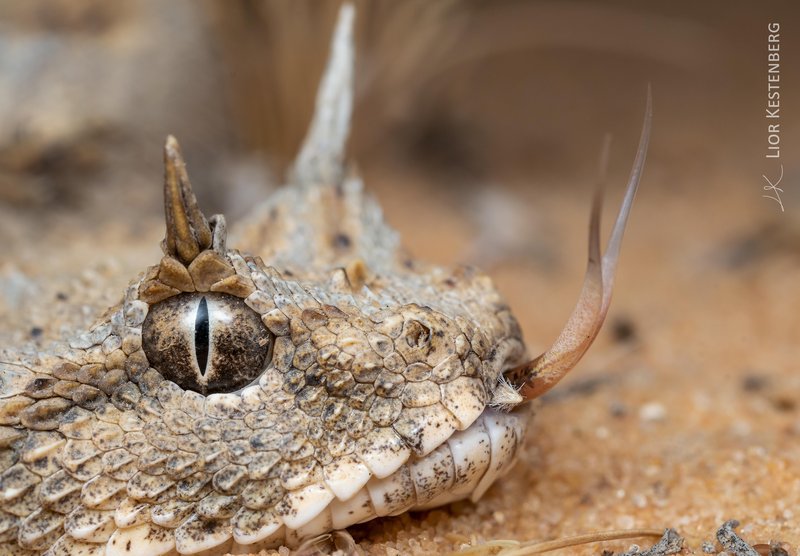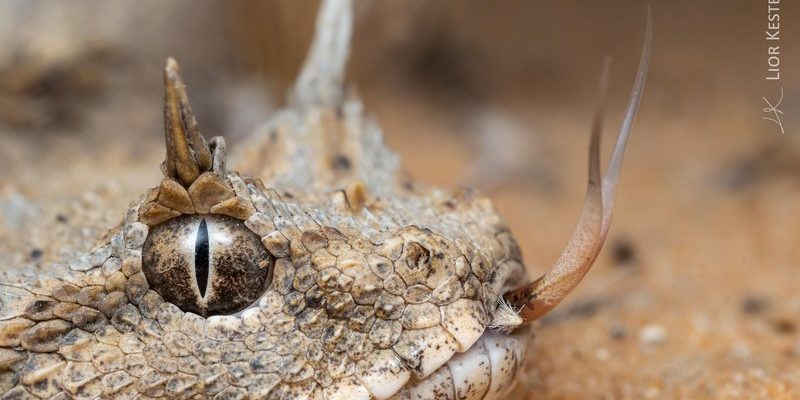
Let’s talk about the Desert Horned Viper, an intriguing snake that calls the arid landscapes of the southwestern United States and Mexico its home. With its distinctive horn-like scales above its eyes, this viper doesn’t just look cool; it’s also a fascinating example of nature’s ingenuity. Imagine a creature perfectly adapted to survive in one of the harshest environments on Earth. Sounds incredible, right?
If you’ve ever seen a film where a character encounters a snake in the desert, chances are it’s likely a Desert Horned Viper. This reptile is as much a part of desert lore as it is a remarkable survivor. Its adaptations not only help it camouflage perfectly within the sandy terrain but also make it a skilled predator. So, let’s dig into what makes this snake so special, from its physical traits to its behavior and habitat.
Physical Characteristics
The Desert Horned Viper is a small to medium-sized snake, typically measuring between 30 to 45 inches long. Its coloration varies from beige to light brown, which blends seamlessly with the sandy desert ground. Its most striking feature, of course, is the pair of *horns* above its eyes, which are not actual horns but modified scales. These give it a unique profile and help with camouflage. Just picture a natural piece of art, perfectly melded with its surroundings.
Its body is stocky and robust, which is impressive for a snake of its size. The texture of its scales is rough, helping it grip the sandy substrates it often hides in. This roughness also aids in shedding, allowing the Desert Horned Viper to thrive in its environment. It’s like having built-in tools designed specifically for survival in a challenging habitat.
What about its eyes? Well, the Desert Horned Viper has vertically slit pupils that provide excellent vision, especially at dusk, when it’s most active. This adaptation allows it to hunt effectively during twilight hours when its prey is often more abundant. Imagine having super eyesight at just the right time — that’s the Desert Horned Viper for you!
Habitat and Distribution
The Desert Horned Viper predominantly inhabits the arid regions of the southwestern United States and parts of northern Mexico. Its preferred environments are sandy or rocky deserts, scrublands, and sometimes even areas with sparse vegetation. You can find them in places like the Sonoran Desert and the Mojave Desert, where they lurk beneath the sun, waiting patiently for unsuspecting prey.
One interesting aspect of their habitat is the way they navigate through the sand. They are known for their *sidewinding* movement, which allows them to glide effortlessly across loose substrates without sinking in. This not only helps them travel but also makes it harder for predators to spot them. Imagine walking on a beach without leaving footprints — that’s a bit like what they do in the desert!
While they are primarily terrestrial, they can sometimes be seen basking on rocks or low shrubs. These raised spots provide both warmth and a vantage point for spotting potential meals. It’s a strategic choice that highlights their adaptability to various facets of their natural habitat.
Diet and Hunting Behavior
The Desert Horned Viper is a carnivore, primarily feeding on small mammals, birds, and lizards. It’s not just about what they eat, but also how they hunt. These vipers are ambush predators. They rely on their camouflage to blend into their surroundings, waiting for their prey to come within striking distance. It’s a game of patience, where stillness is often the key to success.
When a suitable target approaches, the Desert Horned Viper strikes with remarkable speed. Their fangs can deliver a potent venom that immobilizes prey almost instantly. This venom is not just for hunting; it plays a critical role in digestion, allowing them to consume animals larger than their own head. Imagine being able to swipe your meal without even having to chew — that’s efficiency at work!
After capturing their prey, Desert Horned Vipers can go several weeks without eating, relying on their stored energy. This long fasting ability is essential for survival in the desert, where food can be scarce. So, just like we might save up a snack for later, this snake has mastered the art of conservation.
Reproduction and Lifespan
Desert Horned Vipers are ovoviviparous, meaning they give birth to live young rather than laying eggs. This trait is relatively rare among snakes and offers several advantages. For instance, live birth allows the young snakes to avoid the risks associated with eggs being laid in an exposed, harsh environment. When the weather heats up, it’s a great strategy!
Typically, mating occurs in the spring. After a gestation period of about 6 months, females can give birth to anywhere from 3 to 20 young at a time. These newborn vipers are fully independent and can hunt on their own right after birth, which is essential for their survival in the unforgiving desert landscape. It’s like they get a head start on life, ready to take on challenges from day one!
In the wild, Desert Horned Vipers can live up to 10 years, although some may reach *15 years* in captivity with proper care. Their lifespan reflects the delicate balance of survival in a desert ecosystem where every day can bring new challenges. So, in many ways, these vipers are not just survivors; they embody the spirit of resilience in a tough environment.
Conservation Status
The Desert Horned Viper is currently listed as of “Least Concern” by the IUCN. However, like many wildlife species, it’s not completely safe from threats. Habitat loss due to urban development, agricultural expansion, and climate change poses significant risks to their populations. Imagine living in a shrinking neighborhood where once you had all the room to roam, and now it’s just getting smaller and smaller!
Conservation efforts focus on habitat preservation and educating the public about the importance of all desert species. These efforts are crucial because every animal plays a role in its ecosystem. The Desert Horned Viper, for instance, helps control the populations of its prey, which in turn affects the overall health of the desert environment. So, supporting wildlife conservation is like giving a nod to our natural neighbors!
Additionally, respecting their natural habitats and avoiding unnecessary disturbances can help ensure they thrive for generations to come. Every small action contributes to a larger goal of protecting these fascinating creatures. It’s all about being good neighbors in the great outdoors!
Interesting Facts
The Desert Horned Viper comes with some truly captivating features beyond what we’ve discussed. Here are a few fun facts that showcase their uniqueness:
- This viper can tolerate high temperatures, making it one of the few snake species that thrive in extremely hot conditions.
- The ‘horns’ above their eyes serve a purpose not just for aesthetics; they help deflect sand and light, enhancing their camouflage.
- They are known for their distinct defensive behaviors, such as rattling their tails, which can mimic the sound of a rattlesnake, scaring off potential threats.
The Desert Horned Viper is more than just a fascinating reptile; it’s a beautiful example of how life adapts to harsh conditions. With its unique physical traits, hunting behaviors, and remarkable ability to thrive in the desert, this viper captures our imagination and teaches us about the resilience of nature. Next time you think of the desert, consider the myriad lives existing within it — including the enigmatic Desert Horned Viper!
FAQ
What is the primary diet of the Desert Horned Viper?
The Desert Horned Viper primarily feeds on small mammals, birds, and lizards. They’re ambush predators, which means they use their excellent camouflage to blend in with the sandy surroundings while waiting for prey to come close. Their venom is potent, allowing them to immobilize their catch quickly, making hunting efficient and effective.
How does the Desert Horned Viper adapt to its harsh environment?
This viper is beautifully adapted to its desert habitat. Its coloration helps it blend into the sandy substrate, making it nearly invisible to both predators and prey. Additionally, their sidewinding movement enables them to traverse loose sand without sinking, while their unique physiological traits allow for water conservation, crucial for survival in extremely arid conditions.
Where can I find Desert Horned Vipers?
You can find Desert Horned Vipers primarily in the southeastern parts of the United States, specifically within the Sonoran and Mojave deserts. They thrive in sandy or rocky terrains and often hide beneath rocks or vegetation. In the evenings, they are more active, which is when you might spot them basking or hunting.
Are Desert Horned Vipers dangerous to humans?
While the Desert Horned Viper is venomous, it is generally not aggressive toward humans unless threatened. If you encounter one in the wild, it’s best to keep your distance. Their bite can be painful and requires medical attention, but bites are rare as they prefer to avoid confrontation. It’s always wise to be cautious and respectful of their space when exploring their habitats.
How do Desert Horned Vipers reproduce?
Desert Horned Vipers are ovoviviparous, meaning they give birth to live young after a gestation period of about six months. The female can give birth to 3 to 20 young at a time, and these newborns are independent from the moment they are born. This reproductive strategy helps them avoid the dangers associated with laying eggs in a harsh desert environment.
How long do Desert Horned Vipers live?
In the wild, Desert Horned Vipers can live up to 10 years, but in captivity, with proper care, they may last up to 15 years or more. Their lifespan is dependent on environmental factors, availability of food, and threats from predators. In a controlled environment, they can thrive and be well cared for, increasing their lifespan significantly.
What are the main threats to the Desert Horned Viper?
While listed as “Least Concern” by the IUCN, Desert Horned Vipers still face various threats, primarily from habitat loss due to urbanization and climate change. Additionally, human expansion into their habitats can lead to increased mortality rates from vehicles and other dangers. Conservation efforts aim to mitigate these risks by preserving their natural habitats.
Can Desert Horned Vipers be kept as pets?
While it is possible to keep Desert Horned Vipers as pets, it’s essential to understand their specific care needs. They require special habitats that mimic their natural environment and have specific dietary needs. Additionally, maintaining a stable temperature and humidity level is crucial for their health. Always check local regulations and consult expert herpetologists before considering one as a pet.
What is the significance of the ‘horns’ on the Desert Horned Viper?
The ‘horns’ are actually modified scales and serve multiple purposes. They help with camouflage by breaking up the outline of the snake against the sandy landscape. Additionally, they can deflect sand and light, helping the viper to remain hidden from both predators and prey. This unique feature contributes to their survival in the harsh desert environment.
How do Desert Horned Vipers regulate their body temperature?
Desert Horned Vipers are ectothermic, meaning they rely on external sources to regulate their body temperature. They often bask in the sun during the day to warm up, then seek shade or burrow into the sand to cool off. This behavior helps them maintain an optimal body temperature necessary for their metabolic functions and overall health.

